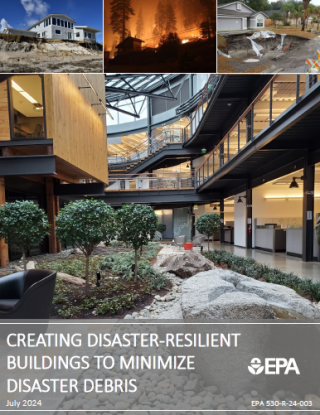Mitigating Debris Before and After a Disaster
Disaster debris depletes valuable, limited landfill space, poses significant risk to human health and the environment, and burdens communities, transporters, and waste management facilities. The entire disaster management cycle – from mitigation to preparedness to response to recovery – presents opportunities to minimize debris.
Total prevention of disaster debris may not be possible, but strategies can be implemented to conserve resources, reduce waste, and lessen environmental impacts by looking upstream to generate less debris in the first place and downstream to develop plans and infrastructure to manage generated debris more sustainably, increasing community resilience.
By mitigating disaster debris, a community may, in the event of a disaster:
- Recover faster, encouraging residents and businesses to stay in the area.
- Release less harmful materials, minimizing hazardous debris and possible contamination.
- Reduce disruption of critical services, including power and water.
- Spend less money on cleanup and debris management.
- Use fewer resources to rebuild and recover.
- Decrease greenhouse gas emissions.
On this page:
Resilience Strategies
Communities can mitigate disaster debris before and after a disaster by:
- Developing pre-incident disaster debris management plans that are scalable to both large and small disasters, laying the groundwork for a community’s preparedness and response to all hazards.
- Increasing material and waste management capacity to handle surges in necessary reuse, recycling, composting, treatment, and disposal of debris.
Expanding reuse, recycling, and composting opportunities for all types of disaster debris.
- Use building materials recovered (pdf)(5 MB) after a disaster to repair or rebuild structures.
- Search EPA’s Disaster Debris Recovery Tool of over 20,000 facilities that are capable of managing different materials that may be found in disaster debris.
- Explore EPA’s Planning for Natural Disaster Debris guidance for additional ideas for reusing, recycling, and composting debris.
- Assessing waste management-related vulnerabilities from current and future hazards.
- Increase resilience of material and waste management facilities, buildings, and other infrastructure.
- Ensure resilience of material and waste management operations, including waste collection, transportation, and reuse, recycling, composting, and recovery services, as well as operations at transfer stations, debris management sites, and material and waste management facilities.
- Designing and retrofitting the built environment, including buildings, waste management facilities, roads and bridges, and other infrastructure, to better withstand disasters.
- Implementing source reduction and hazard mitigation activities to reduce the amount and toxicity of potential debris.
- Adopt or update hazard-resistant building codes and standards.
- Deconstruct – take apart for reuse and recycling – abandoned buildings that could add to potential disaster debris.
- Increase resilience of contaminated sites and facilities that contain harmful materials to disasters to minimize potential contamination of surrounding areas.
- Reduce and remove from existing structures and the community-at-large any accumulation of materials and wastes of concern, such as household hazardous waste.
- Eliminate potential problematic wastes, such as retrofitting PCB transformers and mercury- containing CFL lighting to reduce PCB-contaminated and mercury wastes.
- Support managed retreat (pdf)(4.4 MB), which involves gradually moving structures and infrastructure away from an area that has become too hazardous due to threats, such as wildfires or flooding.
- Reduce or avoid development in high-risk areas (e.g., floodplains).
- Implement nature-based solutions (e.g., restore wetlands).
- Educating residents on ways to protect their homes, businesses, and property from all hazards.
Creating Disaster-Resilient Buildings
Creating disaster-resilient buildings can minimize disaster debris while advancing a circular economy, conserving resources, decreasing waste, and reducing health, social, environmental, and economic impacts.

EPA’s Creating Disaster-Resilient Buildings to Minimize Disaster Debris (pdf)(8.41 MB) provides practical actions on planning, designing, improving, and adapting new and existing buildings to withstand natural disasters.
Community leaders and members, planners, designers, builders, and disaster response experts can use this information to increase the resilience of homes, businesses, and other buildings to the impacts of natural disaster hazards, including flooding, fire, and high winds. This information can be applied in all communities, especially those where community involvement and investments in resilience are critically needed.
This document highlights proven, innovative strategies for disaster-resilient buildings. Inspired by nature and lived experience, these best practices are organized by what can be done before a disaster, in anticipation of an imminent disaster, and after a disaster. Some examples from the document include:
- Rebuild to meet the most recent building codes.
- Design for disassembly and adaptation.
- Ensure external doors and windows open outward.
- Install additional water barriers and bracing systems.
- Raise Heating, Ventilation, and Air Conditioning (HVAC) and electrical systems above anticipated flood levels.
- Screen external vents with 1/8-inch or 1/16- inch metal mesh to reduce the entrance of embers from fires.
It also presents lessons learned from two natural disasters, which illustrate the need for resilient buildings and strategies, and provides resources on debris management, disaster planning, and resiliency.
Mitigation and Resilience Resources
Best Practices for Reducing, Reusing, and Recycling Construction and Demolition Materials.
Community Resilience Planning: A Decision-Making Framework for Coastal Communities.
Deconstruction Rapid Assessment Tool.
Disaster Resilient Design Concepts.
Regional Resilience Toolkit: 5 Steps to Build Large-Scale Resilience to Natural Disasters.
Resiliency and Natural Disaster Debris Workshops.
Sustainable Management of Construction and Demolition Materials.
